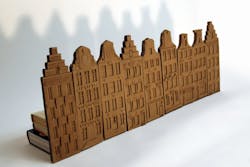Talk about a win-win scenario!
My wife still remembers how excited she was upon learning that medical science had found chocolate yielded actual health benefits! And according to the experts, the darker the chocolate the healthier it is.
Dark chocolate is typically 50-90% cocoa solids compared to milk chocolate’s 10-30%. Dark chocolate contains minerals, antioxidants, and flavonoids, which can lower bad cholesterol levels and prevent arterial plaque, lower blood pressure, reduce inflammation, and improve brain function. It can also act a lot like caffeine, boosting energy and improving alertness and mood.
Now we are learning that a byproduct of chocolate production may also help fight climate change.
According to the United Nation’s Intergovernmental Panel on Climate Change (IPCC), biochar – which can be made from cocoa husks, the shells left over from chocolate production – could potentially capture 2.6 billion metric tons of CO2 per year. According to the International Biochar Initiative, biochar is "the solid material obtained from the thermochemical conversion of biomass in an oxygen-limited environment."
Circular Carbon GmbH, a company located near a chocolate factory in Germany, has been producing biochar from cocoa husks for fertilizer and animal feed additive. They heat the cocoa husks to 600 deg. C. (1,112 deg. F.) in an oxygen-free environment, using a process known as pyrolysis.
The CO2 in the cocoa husks is then sequestered in the biochar, and when used as fertilizer or in “green” concrete, the CO2 is trapped for hundreds of years. If the husks were instead landfilled, they would release that CO2 to the atmosphere as they decomposed.
Interestingly, biochar was being produced by indigenous peoples in the Amazon rainforest well before Christopher Columbus's historic voyage of 1492. They covered burning biomass with soil and let it smolder in pits or trenches, possibly using it to enhance their nutrient-poor soil.
Today, small farmers in developing countries still produce biochar using a similar technique. Unfortunately, that process, rather than sequestering the CO2 captured during the biomass growth, releases it back into the air along with black carbon and other greenhouse gases (GHGs). In order to effectively sequester the CO2, regardless of the biomass (cocoa or other), a pyrolytic process must be used.
There is one major caveat, however.
Pyrolysis is a relatively expensive process and, although the resulting biogas produced can be sold commercially, it will offset only a fraction of the cost of production. In order to achieve the scale necessary to realize the IPCC’s vision of using biochar to sequester 6.5% of the world’s anthropogenic CO2 , significant improvements in production will have to be made, and new applications identified.
In the meantime, eat more (dark) chocolate. Even if it doesn’t yet counteract climate change, it will still make you feel better in several other ways!
A regular contributor to HPAC Engineering and a member of its editorial advisory board, the author is a principal at Sustainable Performance Solutions LLC, a south Florida-based engineering firm focusing on energy and sustainability. He can be reached at [email protected].
About the Author
Larry Clark
A member of HPAC Engineering’s Editorial Advisory Board, Lawrence (Larry) Clark, QCxP, GGP, LEED AP+, is principal of Sustainable Performance Solutions LLC, a South Florida-based engineering firm focused on energy and sustainability consulting. He has more than two dozen published articles on HVAC- and energy-related topics to his credit and frequently lectures on green-building best practices, central-energy-plant optimization, and demand-controlled ventilation.
